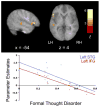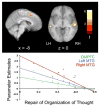Semantic Processing and Thought Disorder in Childhood-Onset Schizophrenia: Insights from fMRI
- PMID: 22147958
- PMCID: PMC3229826
- DOI: 10.1016/j.jneuroling.2009.07.004
Semantic Processing and Thought Disorder in Childhood-Onset Schizophrenia: Insights from fMRI
Abstract
Impairments in language processing and thought disorder are core symptoms of schizophrenia. Here we used fMRI to investigate functional abnormalities in the neural networks subserving sentence-level language processing in childhood-onset schizophrenia (COS). Fourteen children with COS (mean age: 13.34; IQ: 95) and 14 healthy controls (HC; mean age: 12.37; IQ: 104) underwent fMRI while performing a semantic judgment task previously shown to differentially engage semantic and syntactic processes. We report four main results. First, different patterns of functional specialization for semantic and syntactic processing were observed within each group, despite similar level of task performance. Second, after regressing out IQ, significant between-group differences were observed in the neural correlates of semantic and, to a lesser extent, syntactic processing, with HC children showing overall greater activity than COS children. Third, while these group differences were not related to effects of medications, a significant negative correlation was observed in the COS group between neuroleptic dosage and activity in the left inferior frontal gyrus for the semantic condition. Finally, COS children's level of thought disorder was significantly correlated with task-related activity in language-relevant networks. Taken together, these findings suggest that children with COS exhibit aberrant patterns of neural activity during semantic, and to a lesser extent syntactic, processing and that these functional abnormalities in language-relevant networks are significantly related to severity of thought disorder.
Figures






Similar articles
-
Neural correlates of semantic and syntactic processing in German Sign Language.Neuroimage. 2019 Oct 15;200:231-241. doi: 10.1016/j.neuroimage.2019.06.025. Epub 2019 Jun 17. Neuroimage. 2019. PMID: 31220577
-
What role does the anterior temporal lobe play in sentence-level processing? Neural correlates of syntactic processing in semantic variant primary progressive aphasia.J Cogn Neurosci. 2014 May;26(5):970-85. doi: 10.1162/jocn_a_00550. Epub 2013 Dec 17. J Cogn Neurosci. 2014. PMID: 24345172 Free PMC article. Clinical Trial.
-
Syntactic and Semantic Specialization and Integration in 5- to 6-Year-Old Children during Auditory Sentence Processing.J Cogn Neurosci. 2020 Jan;32(1):36-49. doi: 10.1162/jocn_a_01477. Epub 2019 Oct 9. J Cogn Neurosci. 2020. PMID: 31596168 Free PMC article.
-
Context effects in language comprehension: The role of emotional state and attention on semantic and syntactic processing.Front Hum Neurosci. 2022 Nov 25;16:1014547. doi: 10.3389/fnhum.2022.1014547. eCollection 2022. Front Hum Neurosci. 2022. PMID: 36504628 Free PMC article. Review.
-
Neural mechanisms of language comprehension: challenges to syntax.Brain Res. 2007 May 18;1146:23-49. doi: 10.1016/j.brainres.2006.12.063. Epub 2006 Dec 23. Brain Res. 2007. PMID: 17400197 Review.
Cited by
-
Semantics, pragmatics, and formal thought disorders in people with schizophrenia.Neuropsychiatr Dis Treat. 2013;9:177-83. doi: 10.2147/NDT.S38676. Epub 2013 Feb 7. Neuropsychiatr Dis Treat. 2013. PMID: 23430043 Free PMC article.
-
Neural correlates of formal thought disorder: An activation likelihood estimation meta-analysis.Hum Brain Mapp. 2017 Oct;38(10):4946-4965. doi: 10.1002/hbm.23706. Epub 2017 Jun 27. Hum Brain Mapp. 2017. PMID: 28653797 Free PMC article. Review.
-
Thought disorder and communication deviance as predictors of outcome in youth at clinical high risk for psychosis.J Am Acad Child Adolesc Psychiatry. 2011 Jul;50(7):669-80. doi: 10.1016/j.jaac.2011.03.021. Epub 2011 Jun 2. J Am Acad Child Adolesc Psychiatry. 2011. PMID: 21703494 Free PMC article.
-
Language and brain volumes in children with epilepsy.Epilepsy Behav. 2010 Mar;17(3):402-7. doi: 10.1016/j.yebeh.2010.01.009. Epub 2010 Feb 10. Epilepsy Behav. 2010. PMID: 20149755 Free PMC article.
-
Alteration of Semantic Networks during Swear Words Processing in Schizophrenia.Clin Psychopharmacol Neurosci. 2019 Feb 28;17(1):64-73. doi: 10.9758/cpn.2019.17.1.64. Clin Psychopharmacol Neurosci. 2019. PMID: 30690941 Free PMC article.
References
-
- Assaf M, Rivkin PR, Kuzu CH, Calhoun VD, Kraut MA, Groth KM, et al. Abnormal object recall and anterior cingulate overactivation correlate with formal thought disorder in schizophrenia. Biological Psychiatry. 2006;59(5):452–9. - PubMed
-
- Baltaxe CA, Simmons JQ. Speech and language disorders in children and adolescents with schizophrenia. Schizophrenia Bulletin. 1995;21(4):677–92. - PubMed
-
- Bookheimer S. Functional MRI of language: New approaches to understanding the cortical organization of semantic processing. Annual Review of Neuroscience. 2002;25:151–88. - PubMed
-
- Brauer J, Friederici AD. Functional neural networks of semantic and syntactic processes in the developing brain. Journal of Cognitive Neuroscience. 2007;19(10):1609–23. - PubMed
Grants and funding
LinkOut - more resources
Full Text Sources
